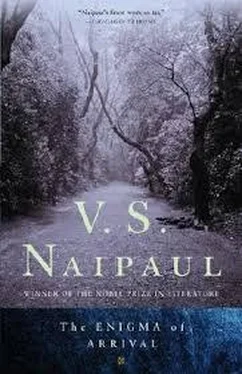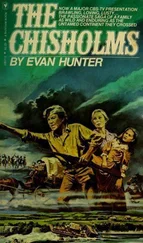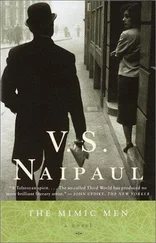V. Naipaul - The Enigma of Arrival
Здесь есть возможность читать онлайн «V. Naipaul - The Enigma of Arrival» весь текст электронной книги совершенно бесплатно (целиком полную версию без сокращений). В некоторых случаях можно слушать аудио, скачать через торрент в формате fb2 и присутствует краткое содержание. Год выпуска: 2012, Издательство: Picador, Жанр: Современная проза, на английском языке. Описание произведения, (предисловие) а так же отзывы посетителей доступны на портале библиотеки ЛибКат.
- Название:The Enigma of Arrival
- Автор:
- Издательство:Picador
- Жанр:
- Год:2012
- ISBN:нет данных
- Рейтинг книги:3 / 5. Голосов: 1
-
Избранное:Добавить в избранное
- Отзывы:
-
Ваша оценка:
- 60
- 1
- 2
- 3
- 4
- 5
The Enigma of Arrival: краткое содержание, описание и аннотация
Предлагаем к чтению аннотацию, описание, краткое содержание или предисловие (зависит от того, что написал сам автор книги «The Enigma of Arrival»). Если вы не нашли необходимую информацию о книге — напишите в комментариях, мы постараемся отыскать её.
The Enigma of Arrival — читать онлайн бесплатно полную книгу (весь текст) целиком
Ниже представлен текст книги, разбитый по страницам. Система сохранения места последней прочитанной страницы, позволяет с удобством читать онлайн бесплатно книгу «The Enigma of Arrival», без необходимости каждый раз заново искать на чём Вы остановились. Поставьте закладку, и сможете в любой момент перейти на страницу, на которой закончили чтение.
Интервал:
Закладка:
In my welcoming cottage, hidden by layer upon layer of beech and yew from the public road, I began to feel oppressed by the labors and strains of the last twenty years; the strains connected with writing, that passion; the personal strains as well that had begun that day when the Pan American World Airways plane had taken me up and shown me that pattern of the fields I had been surrounded by as a child in Trinidad but had never seen till that moment.
All the work, all the strain, all the disappointments and recoveries, now seemed to sit in a solid mass in my head. But I had no vision now of being a corpse at the bottom of a river; no dream of an exploding head that left me shaken up, exhausted, after a struggle to wake. All the stress had turned to fever. So that in my welcoming cottage I was like a child again. As though I had at last, after twenty years, traveled to the equivalent of the fantasy I had had in mind when I left home.
And it was in this mood that when I recovered sufficiently to go outside, I began — with the encouragement of Mr. and Mrs. Phillips, who asked me to dismiss the idea that I might be trespassing on my landlord’s privacy — to explore the spring of the overgrown garden. The spring that had begun for me, and had been fixed for me, by the peony pushing up tight, swelling buds on rhubarblike stalks below the sitting-room window of my cottage.
In my twenty years off and on in England I must have seen many thousands of peonies. They were a common flower, as I was to see when I was fit enough to take bus rides into Salisbury. Right through the valley, in open, sun-struck gardens, small and large, country-cottage or suburban-style gardens, I saw them blooming away too fast in bright light, losing their tightness and deep color, rapidly losing their virtue. None of the many thousands I had seen before this spring had made an impression on me; I had never been able to put the name “peony” to any of them; I had never been able to attach them to a season or a time of year or to the appearance of other flowers or to other natural events. These peonies of my convalescence, these peonies around my cottage, were my first; and they stood for my new life.
The clump outside the sitting-room window was on the north of the cottage; there was another clump, in the shade of the yew hedge between my cottage and the forester’s hut. They came out slowly, preserving their shape, developing an especially deep color. From the lane below the yews and the beeches, the peonies of my cottage made two deep points of color in an otherwise green expanse, edged with wilderness.
O NCE THERE were sixteen gardeners. Now there was only Pitton. He grew vegetables in the walled garden; there he also grew certain flowers for the manor and my landlord; he looked after a private lawn of my landlord’s somewhere else in the grounds. He was like Jack, marking out and maintaining areas of cultivation in the midst of wasteland. But much of what Pitton did was hidden from me. What I saw was mainly wilderness, through which once or twice in the season Pitton would cut — for him and me — the narrowest of paths, quite literally. One swath up; one swath down.
This two-swathed path of Pitton’s began at the end of the lawn, almost opposite the shaded lane that led from the public road. The path ran through an enclosure hedged with old box, unpruned, grown out now almost into trees, meeting above the entrance to make an arch, almost as if that had been intended. The enclosure was empty, without any sign of old planting or old flower beds. In one corner a sycamore had been planted or had seeded itself (there were a number of sycamores about, growing apparently at random); and on this sycamore, a tree now rather than a sapling, someone had trailed a wisteria vine — itself now an old thing, speaking of the old days and the many gardeners and of people having the time and means and wish to embellish a hidden corner.
In the winter the enclosure had been full of the dried-up stalks of weeds, sometimes as tall as dried maize plants, and clumps of thin, long-bladed grass. Now the weeds, on succulent, thick, green stalks were growing tall again. But in spite of those weeds and the wild grass, the path Pitton had cut, one swath up, one swath down, showed grass as tight and fine and level as the grass of a lawn — as though the wilderness was only on the surface and awaited only this cut to reveal the old order and beauty and many seasons’ tending that lay beneath.
This enclosure seemed to be part of the garden of the manor. But I was told by Bray, the car-hire man, that it was older; and the overgrown box hedge suggested a greater age. The enclosure belonged to the house that was here before the manor, Bray said; and he said that before that, there had been a monastery or nunnery on the site. The idea was not a fantastic one. In medieval times everything would have lain along the little river; just a few miles away, at Amesbury, where the river went wide and shallow and clear, there was an abbey and perhaps also the remnant of the nunnery to which Guinevere came from Winchester-Camelot when the Round Table of King Arthur broke up.
An enclosure, then, as stripped of human presence as that damp stone ruin on the droveway, the stone ruin surrounded by sycamores that, ignoring the decay and death of the house they were intended to shelter, continued to grow, casting a cold shade on the black, grassless earth — as stripped as that far-off ruin, this emptiness within the tall box hedge, just a few steps from my cottage, where (if Bray was right) religious men or women of another age, renouncers of the world perhaps, pampered people, possibly also half prisoners, had taken the air or told their beads, secluded in the medieval huddle of a village, between the village center of church and churchyard and the busy river and wet fields, water meadows, busy with peasant labor turning over the heavy, rich black earth.
At the end of this enclosure was the orchard. Old, even decayed, it stood among older forest trees; and the box hedge here was straggly; at the exit the top branches did not meet to form an arch. From here, until the summer green hid it, the river and the willows could be seen across the water meadows — not cropped now, the meadows, no hay taken off them, never busy, and closed even to cattle. No question of taking a shortcut across the water meadows to the river. The land was permanently “drowned,” cut up by choked channels, and with the remnants (like minor Roman engineering ruins) of abandoned control hatches.
It was said that the secrets of drowning and draining the meadows were now lost — labors once as matter-of-fact and seasonal as, say, the water bailiffs’ cleaning of the river and cutting of the over-long river weeds, floating entanglingly up. Once the wealth of the valleys lay in the wet meadows. Now it lay more in the wide, unencumbered uplands. All that grew now in the manor meadows beyond the orchard — and were never cropped — were the wild yellow irises.
One side of the orchard, as you came into it from the enclosure, was like a wood. There were many tall old forest trees and the ground was choked with weeds and tree debris. Suitably, this wood was where the two-story thatched children’s house was. I couldn’t get to it in the spring. There was no path. Pitton cut a path here much later, and then it was a four-swathed path, first for the hand barrow with garden refuse, and then for the big caged barrow or trolley Pitton used to ferry dead leaves to the grass-and-leaf-and-flower graveyard he had established, out of everybody’s sight, at the back of the children’s house.
This vegetable graveyard or rubbish dump Pitton described as a “garden refuge,” and a certain amount of ingenuity went into finding or creating these hidden but accessible “refuges.” That was how Pitton used the word: I believe he had two or three such refuges at different places. Refuse, refuge: two separate, unrelated words. But “refuge,” which Pitton used for “refuse,” did in the most remarkable way contain both words. Pitton’s “refuge” not only stood for “refuse,” but had the additional idea or association, not at all inappropriate, of asylum, sanctuary, hiding, almost of hide-and-seek, of things kept decently out of sight and mind. He might say, of a fallen beech branch on the lawn, or a heap of grass clippings: “That’ll be going to the refuge.” Or: “I’ll take it down to the refuge presently.”
Читать дальшеИнтервал:
Закладка:
Похожие книги на «The Enigma of Arrival»
Представляем Вашему вниманию похожие книги на «The Enigma of Arrival» списком для выбора. Мы отобрали схожую по названию и смыслу литературу в надежде предоставить читателям больше вариантов отыскать новые, интересные, ещё непрочитанные произведения.
Обсуждение, отзывы о книге «The Enigma of Arrival» и просто собственные мнения читателей. Оставьте ваши комментарии, напишите, что Вы думаете о произведении, его смысле или главных героях. Укажите что конкретно понравилось, а что нет, и почему Вы так считаете.












